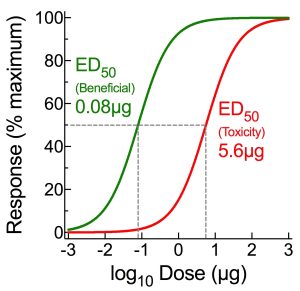Therapeutic index

The therapeutic index for a drug provides a quantitative indication of the effective dose range (the size of the therapeutic window) within which a drug may be used without risk of serious side effects.
There are various ways in which a drug’s therapeutic index may be expressed. Perhaps the most common, and the most useful, is to express therapeutic index as the ratio of the ED50 that causes 50% of the maximal primary toxic response to the ED50 that elicits 50% of the maximum beneficial (therapeutic) response. Toxicity in this regard refers to a side-effect that is sufficiently serious to require an immediate dose reduction or termination of therapy. This concept is illustrated in the figure on the left.
The higher the value for therapeutic index, the larger the therapeutic window. Most drugs have a therapeutic index of 100 or higher, but several commonly-used drugs have indices lower than 10. These drugs present far greater risks to patients, and use is often accompanied by therapeutic drug monitoring.
A similar approach to expressing therapeutic index, perhaps more suitable for drugs acting in a quantal manner, is to use the ratio of the dose in humans that causes toxicity in 50% of patients (TD50) to the dose in humans that gives a beneficial effect in 50% of patients (ED50) (i.e., a ratio of TD50/ED50). Occasionally, a simple ratio of MTC/MEC may also be used.

